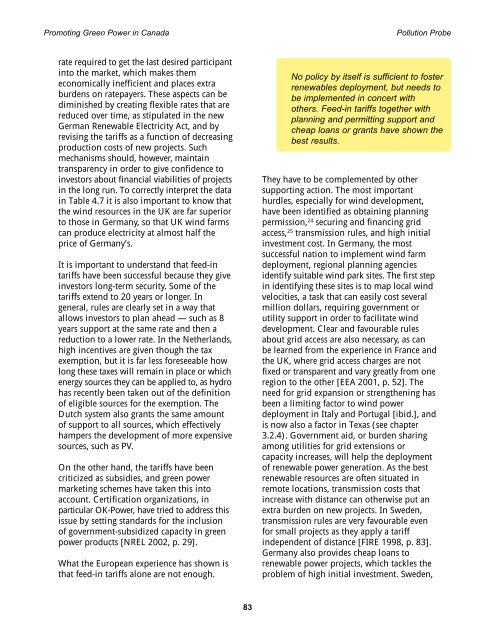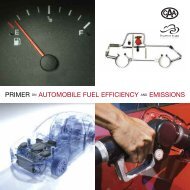Promoting Green Power in Canada - Centre for Human Settlements
Promoting Green Power in Canada - Centre for Human Settlements
Promoting Green Power in Canada - Centre for Human Settlements
- No tags were found...
You also want an ePaper? Increase the reach of your titles
YUMPU automatically turns print PDFs into web optimized ePapers that Google loves.
<strong>Promot<strong>in</strong>g</strong> <strong>Green</strong> <strong>Power</strong> <strong>in</strong> <strong>Canada</strong> Pollution Proberate required to get the last desired participant<strong>in</strong>to the market, which makes themeconomically <strong>in</strong>efficient and places extraburdens on ratepayers. These aspects can bedim<strong>in</strong>ished by creat<strong>in</strong>g flexible rates that arereduced over time, as stipulated <strong>in</strong> the newGerman Renewable Electricity Act, and byrevis<strong>in</strong>g the tariffs as a function of decreas<strong>in</strong>gproduction costs of new projects. Suchmechanisms should, however, ma<strong>in</strong>ta<strong>in</strong>transparency <strong>in</strong> order to give confidence to<strong>in</strong>vestors about f<strong>in</strong>ancial viabilities of projects<strong>in</strong> the long run. To correctly <strong>in</strong>terpret the data<strong>in</strong> Table 4.7 it is also important to know thatthe w<strong>in</strong>d resources <strong>in</strong> the UK are far superiorto those <strong>in</strong> Germany, so that UK w<strong>in</strong>d farmscan produce electricity at almost half theprice of Germany’s.It is important to understand that feed-<strong>in</strong>tariffs have been successful because they give<strong>in</strong>vestors long-term security. Some of thetariffs extend to 20 years or longer. Ingeneral, rules are clearly set <strong>in</strong> a way thatallows <strong>in</strong>vestors to plan ahead — such as 8years support at the same rate and then areduction to a lower rate. In the Netherlands,high <strong>in</strong>centives are given though the taxexemption, but it is far less <strong>for</strong>eseeable howlong these taxes will rema<strong>in</strong> <strong>in</strong> place or whichenergy sources they can be applied to, as hydrohas recently been taken out of the def<strong>in</strong>itionof eligible sources <strong>for</strong> the exemption. TheDutch system also grants the same amountof support to all sources, which effectivelyhampers the development of more expensivesources, such as PV.On the other hand, the tariffs have beencriticized as subsidies, and green powermarket<strong>in</strong>g schemes have taken this <strong>in</strong>toaccount. Certification organizations, <strong>in</strong>particular OK-<strong>Power</strong>, have tried to address thisissue by sett<strong>in</strong>g standards <strong>for</strong> the <strong>in</strong>clusionof government-subsidized capacity <strong>in</strong> greenpower products [NREL 2002, p. 29].What the European experience has shown isthat feed-<strong>in</strong> tariffs alone are not enough.No policy by itself is sufficient to fosterrenewables deployment, but needs tobe implemented <strong>in</strong> concert withothers. Feed-<strong>in</strong> tariffs together withplann<strong>in</strong>g and permitt<strong>in</strong>g support andcheap loans or grants have shown thebest results.They have to be complemented by othersupport<strong>in</strong>g action. The most importanthurdles, especially <strong>for</strong> w<strong>in</strong>d development,have been identified as obta<strong>in</strong><strong>in</strong>g plann<strong>in</strong>gpermission, 24 secur<strong>in</strong>g and f<strong>in</strong>anc<strong>in</strong>g gridaccess, 25 transmission rules, and high <strong>in</strong>itial<strong>in</strong>vestment cost. In Germany, the mostsuccessful nation to implement w<strong>in</strong>d farmdeployment, regional plann<strong>in</strong>g agenciesidentify suitable w<strong>in</strong>d park sites. The first step<strong>in</strong> identify<strong>in</strong>g these sites is to map local w<strong>in</strong>dvelocities, a task that can easily cost severalmillion dollars, requir<strong>in</strong>g government orutility support <strong>in</strong> order to facilitate w<strong>in</strong>ddevelopment. Clear and favourable rulesabout grid access are also necessary, as canbe learned from the experience <strong>in</strong> France andthe UK, where grid access charges are notfixed or transparent and vary greatly from oneregion to the other [EEA 2001, p. 52]. Theneed <strong>for</strong> grid expansion or strengthen<strong>in</strong>g hasbeen a limit<strong>in</strong>g factor to w<strong>in</strong>d powerdeployment <strong>in</strong> Italy and Portugal [ibid.], andis now also a factor <strong>in</strong> Texas (see chapter3.2.4). Government aid, or burden shar<strong>in</strong>gamong utilities <strong>for</strong> grid extensions orcapacity <strong>in</strong>creases, will help the deploymentof renewable power generation. As the bestrenewable resources are often situated <strong>in</strong>remote locations, transmission costs that<strong>in</strong>crease with distance can otherwise put anextra burden on new projects. In Sweden,transmission rules are very favourable even<strong>for</strong> small projects as they apply a tariff<strong>in</strong>dependent of distance [FIRE 1998, p. 83].Germany also provides cheap loans torenewable power projects, which tackles theproblem of high <strong>in</strong>itial <strong>in</strong>vestment. Sweden,83
















